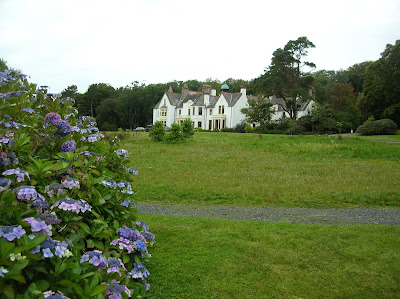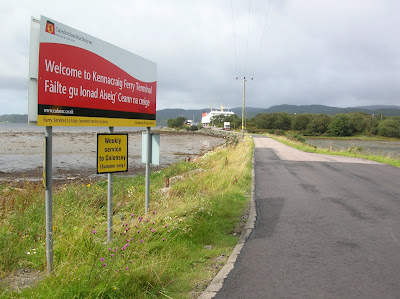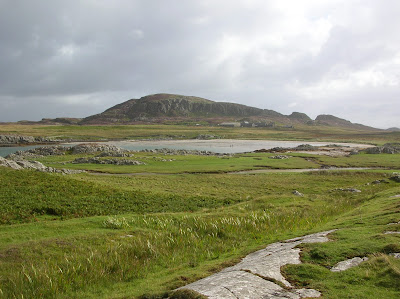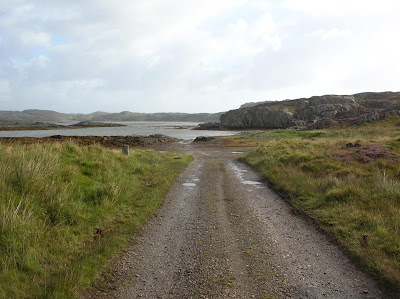When I told people I was going to Gigha almost everyone said they had never heard of it, so maybe the island needs to do more marketing if it wants to attract more visitors. I spent a day and a night on this delightful island in early September 2012.
Ownership of the island passed through a succession of people in the 20th century but in 2002 with the help of grants, loans and fundraising the islanders were able to buy the island, which is now run by the Isle of Gigha Heritage Trust. Since then the population has increased from 110 in 2001 to around 150 in 2012. The Heritage Trust has bought 3 wind turbines, which are known as Faith, Hope and Charity
The main visitor attraction on the island is the gardens at Achamore House. They were planted by Colonel Sir James Horlick (of hot milk drink fame), who bought Gigha in 1944. There are more than 50 acres of woodland gardens, including lots of rhododendrons. The garden is open from dawn until dusk every day and you put your money in the honesty box at the entrance. I had the gardens to myself when I visited, although there had been a coach party visiting earlier in the day. I had a chat to their coach driver on my way to visit the ruined church in Kilchattan. I was surprised that the enormous coach would have fitted on the ferry but it obviously did. He said he had all his coach party's packed lunches with him and offered me some of their sandwiches. I declined but did accept a chunky kit kat. I hope one of his passengers didn't miss it!
There is a hotel at Ardminish and several self-catering properties and people offering bed and breakfast accommodation. I stayed in the excellent Springbank Guest House. My host was friendly and informative and it was very good value for money.
Ardminish Harbour
Walled Garden at Achamore House
Viewpoint - Achamore House Gardens
the island to the left is Eun Eilean, a tidal island, which I didn't manage to visit, as I was only on Gigha for one low tide. However my motto is 'always leave something to come back for'.
the island to the left is Eun Eilean, a tidal island, which I didn't manage to visit, as I was only on Gigha for one low tide. However my motto is 'always leave something to come back for'.
Achamore House Walled Garden
 |
| Achamore House The house was built in 1884 but was badly damaged by fire at the end of the 19th century and was then rebuilt with 2 storeys instead of the original 3. |
The Boathouse Cafe at Ardminish
- sadly it was closed when I visited on a Monday in early September, as they only open at the weekends in winter! I thought early September was still summer!
Ardminish is the main settlement on the island. It is where the ferry comes in and the school, hotel, church and shop/post office are also located here. The shop had all the essentials but I didn't think it was particularly well stocked compared to other island shops I have been in. There is also a gallery selling art and crafts here.
Port a' Chinn Mhoir
 |
| Ardminish Church |
Giant's Tooth Standing Stone beside the road at Tarbert
It is also known as the Hanging Stone, possibly because criminals were hanged from the top of it. It may date back to the Bronze Age.
It is also known as the Hanging Stone, possibly because criminals were hanged from the top of it. It may date back to the Bronze Age.
9 hole Golf Course
Ruined church at Kilchattan
There are several elaborately carved gravestones. The church is dedicated to St Cathan, a 6th century Irish missionary, and dates from the 13th century. It was replaced during the early 18th century by a new church opposite the hotel. This was in turn replaced by the current building in the 1930s.
Ogham Stone at Kilchattan
This is one of only 2 known stones in Scotland with Ogham script carved into them. Ogham is an ancient linear script, which originated in Ireland.
Fisherman's Cave
There is a path to this cave, which is signposted from the road just to the north of Eilean Garbh. The path winds along for about half a mile and is a bit boggy in places. The cave isn't that exciting when you get there but the walk to it is quite scenic. It was used to store nets and creels.
Ardminish
Port Righ at the northern end of the island
I'm not sure what this cairn at Ardminish is for but it was quite pretty
Stained glass window in the Parish Church of Gigha and Cara at Ardminish
One of the stained glass windows in the church is dedicated to Kenneth MacLeod, who wrote the song 'Road to the Isles'. I'm not sure if it is this window or not, as there are several interesting stained glass windows. Kenneth MacLeod was the first minister at the current church, which was built in 1923.


























































